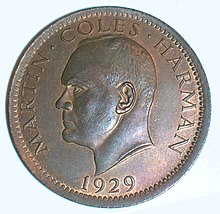Imagination
A fancy coin or fancy coin is a mint that resembles a coin in terms of its external shape , i.e. has a predetermined face value, but was not issued by an official body of a state and is not intended for payment transactions ( pseudo coin ). Fantasy coins differ from counterfeit coins in that they do not imitate real coins and are usually not produced with fraudulent intent. They are also to be distinguished from tokens that are also produced privately but are intended (to a limited extent) for payment purposes.
Historical imagination

With the growing interest in ancient numismatics from the Renaissance onwards, people came up with the idea of making “ancient” coins (with or without the intention of fraud) themselves. In addition to forgeries / replicas of originals, self-designed motifs were also produced, which merely imitated the style of ancient coins. Well-known creators of such coins were Giovanni Cavino , who was responsible for the so-called “ Paduan ” in the 16th century , or the German Karl Wilhelm Becker (1772–1830).
Correctly identified historical fantasy coins are a separate subject of numismatic studies and a collection area. But they can also be stored in collections undetected or sold with fraudulent intent.
Coins from pretenders
Pretenders to the throne or their followers often had their own coins minted in order to underline their claim to the throne (and the privilege to issue coins associated with it). Especially in France, numerous pretenders, such as Louis XVII. or Napoleon IV , immortalized on coins.
Coins of micro and fantasies
Micronations often issue their own currency to underline their alleged sovereignty, but also to make money selling coins, banknotes and stamps. In addition, there are coins made by private companies or coin sales companies for completely fictitious "countries" such as Atlantis , Camelot or Middle-earth .
Fantasy coins from existing states
Fantasy coins bearing the designation of a recognized state or autonomous territory are also often found. In order to stay within the legal framework, the currency names are usually changed or replaced by a fantasy currency. The most common representatives of this type include the “ probeeeuros ”, which are supposed to be trial coins for the euro (mostly from countries that have not yet introduced the euro), but which come from private sources. The authors are mostly coin sales companies who hope to make a profit by selling "official" coins.
Individual evidence
-
^ Moritz Eduard Pinder: The becker counterfeit coins. Nicolaische Buchhandlung, Berlin 1846.
Becker's false coins in the Google book search - ↑ Victor Gadoury: Monnaies Françaises 1789-1981. Monte Carlo 1981, pp. 290-306
- ^ Unusual World Coins, pp. 9, 42, 334
literature
- Colin R. Bruce II: Unusual World Coins. Krause Publications, 5th edition 2007, ISBN 978-0896895768 .
